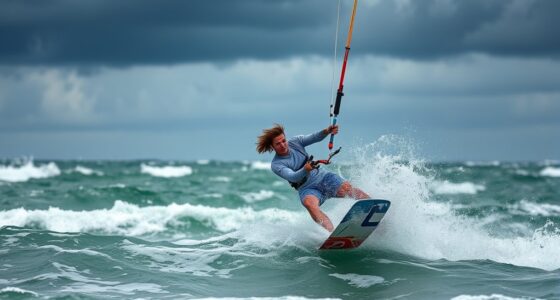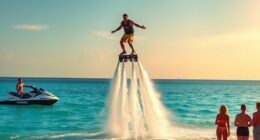Flyboarding lets you soar above the water using a jet-powered propulsion system. Water is drawn in and ejected through nozzles at your feet, creating upward thrust that lifts you high into the air. You’ll feel exhilarated as you perform tricks and gain a unique perspective of your surroundings. Safety is key, so you’ll wear a life jacket and helmet for protection. If you stay with us, you’ll discover even more about the thrilling world of hydroflight technology.
Key Takeaways
- Flyboarding uses water propulsion to lift users above the surface through a jet that draws water and ejects it via foot nozzles.
- The system generates upward thrust by pumping water through a hose connected to a power source, allowing for aerial maneuvers.
- Ejected water creates strong lift, enabling users to experience freedom and control while enjoying a unique bird’s-eye view of their surroundings.
- Safety measures include mandatory life jackets, helmets, and proper instruction to minimize risks during flyboarding activities.
- Responsible use involves maintaining a safe distance from other water users and adhering to environmental guidelines for a safe and enjoyable experience.

As you plunge into the exciting world of hydroflight technology, you’ll discover how this innovative water sport is transforming the way we experience aquatic adventures. Flyboarding, a popular form of hydroflight, utilizes water propulsion to lift you above the surface, giving you a thrilling bird’s-eye view of your surroundings. Imagine soaring over waves or diving back into the water like a dolphin. This mesmerizing activity is not just about the adrenaline rush; it’s also about understanding how the technology works.
At the heart of flyboarding is a powerful jet that draws water from beneath you and ejects it through two nozzles attached to your feet. This water propulsion system creates a force strong enough to lift you several feet into the air, allowing for a unique blend of freedom and exhilaration. The experience can feel like you’re flying, and the control you have over your movements can be quite empowering. With practice, you can master various tricks and maneuvers, turning the water into your personal playground.
However, before you launch into the sky, it’s vital to consider safety precautions. Like any adventure sport, flyboarding requires a level of responsibility to guarantee a secure experience. First and foremost, always wear a life jacket. This isn’t just a recommendation; it’s a necessary safety measure that can save your life if you fall unexpectedly. Additionally, make sure you’re wearing a helmet to protect your head from potential impacts. Knowing how to swim is another fundamental safety precaution; while the equipment can keep you afloat, being a strong swimmer enhances your confidence and safety in the water.
Before you hit the water, familiarize yourself with the equipment and the basic operational controls. Many operators provide a brief training session to guide you through the process, ensuring you’re comfortable with the flyboard and the water propulsion system. Listen attentively to the instructor’s tips on balance and body positioning, as these can greatly influence your experience.
Lastly, always respect the environment and other water users. Maintain a safe distance from boats and fellow swimmers to avoid accidents. By adhering to these safety precautions and understanding how flyboarding works, you’ll not only enhance your enjoyment but also contribute to a safer and more responsible hydroflight experience. Additionally, just like in men’s grooming, maintaining your equipment regularly can ensure optimal performance and safety. So gear up and get ready for an unforgettable adventure above the waves!
Frequently Asked Questions
What Safety Gear Is Recommended for Using a Flyboard?
When using a flyboard, you should wear essential protective equipment to guarantee your safety. Always use a properly fitted life vest, helmet, and, if possible, knee and elbow pads. These safety precautions help minimize injuries in case of falls or accidents. Don’t forget to check your gear beforehand to verify everything’s in good condition. Staying aware of your surroundings while flying also contributes to a safer experience on the water.
How Long Does It Take to Learn Hydroflight?
It usually takes a few hours to get the hang of hydroflight, but your training duration can vary based on your comfort level and previous experience. Most people start to acquire basic skills within the first session, while mastering advanced techniques might take several days or more. You’ll find that consistent practice markedly speeds up your skill acquisition, so don’t hesitate to spend more time on the water!
Are There Age Restrictions for Flyboarding?
Yes, there are age restrictions for flyboarding. Most operators require participants to be at least 12 years old, but some may permit younger kids if they’re accompanied by an adult. Licensing requirements can also differ by location; some places might require a safety briefing or even a specific license. Always check with your local flyboarding provider to guarantee you meet their age and licensing guidelines before you jump in!
What Is the Average Cost of a Flyboarding Session?
A flyboarding session typically costs between $100 and $200 for an hour. Imagine soaring above the water like a superhero! If you’re new to flyboarding, consider renting a flyboard from a local provider. They often offer beginner tips to help you get started. You’ll appreciate the safety gear and instructions, ensuring you have a fantastic time while mastering the basics. Don’t forget to ask about any package deals or discounts!
Can You Flyboard in Saltwater and Freshwater?
Yes, you can flyboard in both saltwater and freshwater. Each water type offers a unique experience, and the equipment performs well in either environment. However, keep in mind that saltwater can cause corrosion over time, impacting the gear’s longevity. You should also consider the environmental impact; flyboarding in natural water bodies may disturb local wildlife. Always prioritize safety and respect for the environment when choosing your flyboarding location. Enjoy your adventure!
Conclusion
So, you thought flying was just for birds and superheroes, huh? Well, with hydroflight technology, you’re only a few straps away from soaring above the water like a pro. Who knew that a mix of water pressure and a little engineering could turn you into a human jetpack? It’s ironic, really—while we’ve spent centuries dreaming of flight, all it took was some water and a flyboard to make it a reality. Now, get out there and fly!









